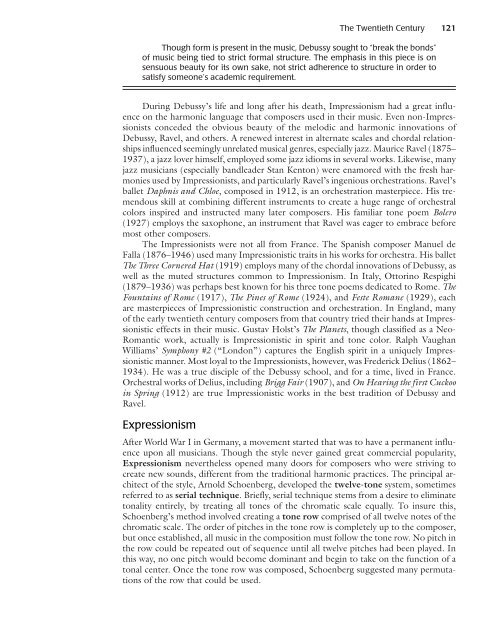Composer Profile - Activefolio
Composer Profile - Activefolio
Composer Profile - Activefolio
You also want an ePaper? Increase the reach of your titles
YUMPU automatically turns print PDFs into web optimized ePapers that Google loves.
The Twentieth Century 121<br />
Though form is present in the music, Debussy sought to “break the bonds”<br />
of music being tied to strict formal structure. The emphasis in this piece is on<br />
sensuous beauty for its own sake, not strict adherence to structure in order to<br />
satisfy someone’s academic requirement.<br />
During Debussy’s life and long after his death, Impressionism had a great influence<br />
on the harmonic language that composers used in their music. Even non-Impressionists<br />
conceded the obvious beauty of the melodic and harmonic innovations of<br />
Debussy, Ravel, and others. A renewed interest in alternate scales and chordal relationships<br />
influenced seemingly unrelated musical genres, especially jazz. Maurice Ravel (1875–<br />
1937), a jazz lover himself, employed some jazz idioms in several works. Likewise, many<br />
jazz musicians (especially bandleader Stan Kenton) were enamored with the fresh harmonies<br />
used by Impressionists, and particularly Ravel’s ingenious orchestrations. Ravel’s<br />
ballet Daphnis and Chloe, composed in 1912, is an orchestration masterpiece. His tremendous<br />
skill at combining different instruments to create a huge range of orchestral<br />
colors inspired and instructed many later composers. His familiar tone poem Bolero<br />
(1927) employs the saxophone, an instrument that Ravel was eager to embrace before<br />
most other composers.<br />
The Impressionists were not all from France. The Spanish composer Manuel de<br />
Falla (1876–1946) used many Impressionistic traits in his works for orchestra. His ballet<br />
The Three Cornered Hat (1919) employs many of the chordal innovations of Debussy, as<br />
well as the muted structures common to Impressionism. In Italy, Ottorino Respighi<br />
(1879–1936) was perhaps best known for his three tone poems dedicated to Rome. The<br />
Fountains of Rome (1917), The Pines of Rome (1924), and Feste Romane (1929), each<br />
are masterpieces of Impressionistic construction and orchestration. In England, many<br />
of the early twentieth century composers from that country tried their hands at Impressionistic<br />
effects in their music. Gustav Holst’s The Planets, though classified as a Neo-<br />
Romantic work, actually is Impressionistic in spirit and tone color. Ralph Vaughan<br />
Williams’ Symphony #2 (“London”) captures the English spirit in a uniquely Impressionistic<br />
manner. Most loyal to the Impressionists, however, was Frederick Delius (1862–<br />
1934). He was a true disciple of the Debussy school, and for a time, lived in France.<br />
Orchestral works of Delius, including Brigg Fair (1907), and On Hearing the first Cuckoo<br />
in Spring (1912) are true Impressionistic works in the best tradition of Debussy and<br />
Ravel.<br />
Expressionism<br />
After World War I in Germany, a movement started that was to have a permanent influence<br />
upon all musicians. Though the style never gained great commercial popularity,<br />
Expressionism nevertheless opened many doors for composers who were striving to<br />
create new sounds, different from the traditional harmonic practices. The principal architect<br />
of the style, Arnold Schoenberg, developed the twelve-tone system, sometimes<br />
referred to as serial technique. Briefly, serial technique stems from a desire to eliminate<br />
tonality entirely, by treating all tones of the chromatic scale equally. To insure this,<br />
Schoenberg’s method involved creating a tone row comprised of all twelve notes of the<br />
chromatic scale. The order of pitches in the tone row is completely up to the composer,<br />
but once established, all music in the composition must follow the tone row. No pitch in<br />
the row could be repeated out of sequence until all twelve pitches had been played. In<br />
this way, no one pitch would become dominant and begin to take on the function of a<br />
tonal center. Once the tone row was composed, Schoenberg suggested many permutations<br />
of the row that could be used.



